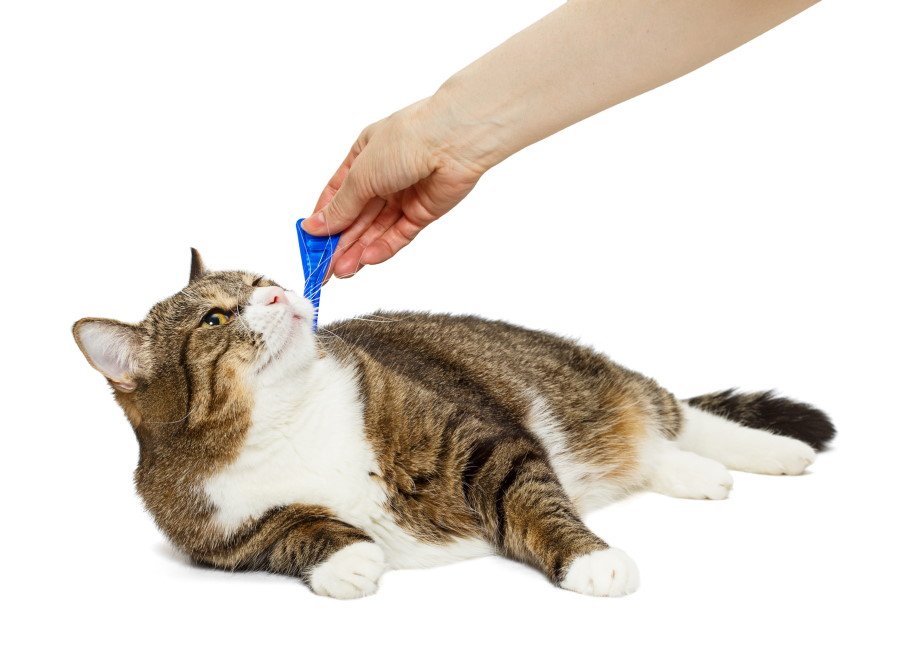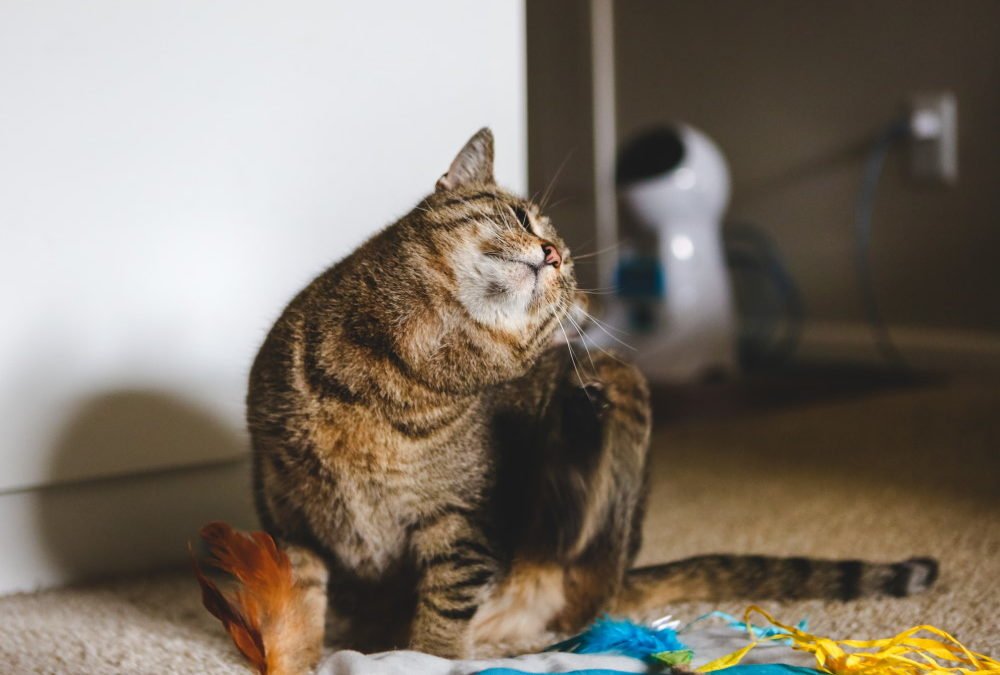Fleas in Cats are an enormous problem although all mammals, especially dogs, are prone to fleas as well, cats that get fleas can be especially challenging. For one thing, cats can go everywhere and spread nits (flea eggs) throughout the furniture and even clothing and bedding so finding the best flea treatment for cats is important!
Dogs are also capable of this, but cats move constantly all day every day from one soft surface to another and even onto kitchen and bathroom counters. Fleas in cats can soon become an army of invaders and may take months to eliminate as if you miss one flea nit, or one flea the problem erupts in full force again almost immediately.
Table of Contents
Prevention is the Best Approach to Fleas in Cats
A great routine veterinary checkup is necessary especially if your cat goes outdoors or there are other animals in the home such as dogs. Having multiple animals, especially multiple cats increases the chances of a flea infestation.
Even if you have no other pets, and your cat does not go outdoors, fleas can be introduced into a household via shoes and other garments by pet parents. Children love to explore the outdoors and hiking and being in vegetation or around other animals in someone else’s home puts a cat at risk for fleas.
Remember, it only takes one nit or one flea to start the ball rolling on a complete takeover of your home and your cats and a takeover is what it is!
Signs of Fleas in Cats
You might not notice the signs immediately as cats can be reclusive when they feel the need. Unlike dogs, they come to be with you when they want, but then go and hide in all manner of nooks and crannies when they want their alone time. This makes it more difficult to spot the signs of fleas on your cat babies.
The signs can be subtle at first. Quickly biting themselves or scratching rapidly with no signs of why they are doing so is generally the first indication. Cats may yowl or whimper when infested and are seeking assistance this way.
Fur-covered scratch polls, cat beds, and cat trees, as well as all hammocks and other cat toys if fuzzy or with openings, unfortunately, should be removed and thrown away at the first suspicion of fleas. Washing some items in a flea soap might help. Better safe than sorry when dealing with these pests.
You might even be noticing itchy spots yourself as fleas do bite humans also. Any blood supply appeals to them.
Fleas Progress Rapidly
As the infestation progresses, the fur may show bald spots or even scabs on the skin from where a cat is scratching repeatedly. The worst-case scenarios are those when a cat becomes irritable and starts to lose weight.
This should lead to an immediate vet visit and a total clean-up of your home and checking all spots your cat or cat frequents to eliminate the fleas. Once a cat becomes irritable and loses weight, it means the fleas are now so prolific that the blood is being drained rapidly from your kitty.
If owning more than one cat, you can safely assume all the cats in your household have fleas. Fleas can jump six feet or more easily and cats routinely lie around in pairs.
The most common type of fleas in cats are brown fleas or black fleas. The brown fleas are most common in cats, and according to Cornell Feline Health University, the most problematic for cats, especially kittens who can die quite quickly from a flea infestation.
Fleas require very little; Just a warm home and food. That IS your cat, however, and that is why fleas are reluctant to leave and reproduce rapidly.

There Are Many Ways to Combat Feline Fleas
Your vet of course is your best source of information. Although many types of flea collars, drops, and flea powders plus baths and dips exist, it is not easy to tell with over-the-counter standard approaches will work. There are many different health issues in some cats and believe it or not many types of fleas!
For many cat parents, getting flea treatment from your veterinarian is a good choice. Solutions like Revolution Plus provide excellent protection, although they can be expensive.
Advantage and Frontline are also popular flea treatments for cats and they’re available on Amazon.
If you have more than one cat vets can recommend that the cat with fleas, be isolated for a while. Medications now exist for flea treatment and are given routinely by many vets, regularly, or in emergency cases. Especially when collars and other topicals do not work, the medications generally have quick effectiveness that can stop or prevent an infestation in its tracks.
Many individuals swear by the medications, and these are even available as chewy treats which makes a cat more amenable to taking these. Vets generally, however, administer these in their offices as a once a year, or once every six-month routine.
Once you know a brand, however, you may be able to purchase these medications online. But be wary of the sites you use so as not to harm your cat.
Outside of Medications, There are Topicals
Topicals involve any spray, flea powder, or gel that is applied at the base of the neck, where more fleas love to hang out. These are available through your vet, which is recommended, with the powders being the least recommended for use on a cat directly.
The powders can assist with flea extermination on furniture and bedding and using powders for that always seems more effective than dousing your cat with powder you have purchased over the counter.
Most vets do not recommend powders, or even sprays, as cats lick themselves, and the ingredients in these can lead to digestive problems, as well as seizures in some cats.
Vets, as stated before are inclined to use prescription medications to treat fleas in cats, and if that is not warranted, they then use a flea collar. Yes, you can also buy these anywhere, but the ones that a vet provides have much more of the ingredients needed to exterminate and prevent fleas.
Purchasing a collar from the vet or using the medication once a year is a better method of flea prevention and treatment hands down over store-bought topicals or collars.
Bathing and Grooming are Also Important
When you first notice fleas, it is time to bathe your cat. And you might need to do it once every several days if the infestation is bad. There are three life cycles of a flea. An egg, larvae, and an adult with most being female and laying about 50 eggs per week.
As you bathe, the adult fleas that are present will jump off or be killed but the ones that jumped ship are still in your environment, so control by your vet is still necessary, and ridding your home of them is also necessary.
Dish soap has been in the news quite a bit like a quick killer of fleas but according to Pet MD, it is not recommended as cat’s skin is already irritated by the fleas and the dish soap can cause additional irritation.
A vet again can recommend and perhaps supply a good shampoo for cats. Special flea combs exist that get deep into the coat of a cat, can alleviate some of the fleas, but no vet will recommend the ‘flea zappers’ you see in stores. These are terrifying to cats and can cause burns.
Remember, fleas are not just pesky but can be deadly. Head to the vet as many times as needed and use their products, if possible, to get an infestation under control. If purchasing in a store look for labels that say, ‘vet recommended’ and at least CALL your vet before using any product for flea prevention or treatment.

Jonathon Hyjek is an entrepreneur and cat-lover. He is married to Joy and they share their home with their 2 feline-friends, Franklin & Ollie. Jonathon is a self-admitted “Crazy Cat Guy”. He started this website because of his love for his own cats and their well-being.

